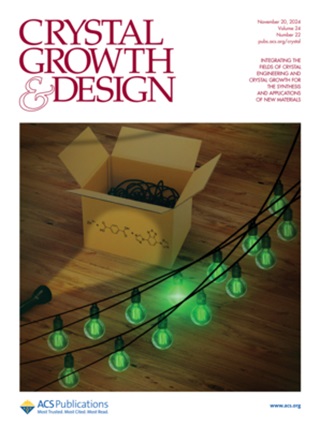作为卤素键受体的金属结合硫和硒位:铑(I)半灯配合物与 1,4-二碘四氟苯的超分子结合
IF 3.4
2区 化学
Q2 CHEMISTRY, MULTIDISCIPLINARY
引用次数: 0
摘要
反式-(Ch,N)-[Rh(μ-Ch∧N)(COD)]2(Ch = S,Se;HCh∧N = 2-噻吩并吡啶 1,2-硒并吡啶 2)是半镧系 Rh2I 配合物;COD = 1,5-环辛二烯)与 1,4-二碘四氟苯(1,4-FIB)共晶体化,得到等结构共晶体 1-1,4-FIB 和 2-1,4-FIB,这两种共晶体都通过 X 射线晶体学进行了研究。结构数据分析揭示了一种一维(1D)超分子排列,这种排列是基于一种探索不足的I---[Ch]-M卤素键。密度泛函理论(DFT)计算采用了一套互补的计算方法,对这些相互作用进行了仔细的研究,并估算出了它们的能量(约-15 kcal/mol)。除了静电和弥散相互作用成分外,LP(Ch) → σ*(I-C)(LP = 孤对)电荷转移也明显促进了卤素键合,并为这种非共价相互作用提供了一些共价特性。所观察和研究的组装为通过配体参与的卤素键(包括 S 或 Se 亲核位点)实现含金属体系的超分子整合提供了一条途径。本文章由计算机程序翻译,如有差异,请以英文原文为准。

Metal-Bound Sulfur and Selenium Sites as Halogen Bond Acceptors: The Supramolecular Association of Rhodium(I) Half-Lantern Complexes with 1,4-Diiodotetrafluorobenzene
The half-lantern Rh2I complexes trans-(Ch,N)-[Rh(μ-Ch∧N)(COD)]2 (Ch = S, Se; HCh∧N = 2-thiopyridine 1, 2-selenopyridine 2; COD = 1,5-cyclooctadiene) were cocrystallized with 1,4-diiodotetrafluorobenzene (1,4-FIB) to give isostructural cocrystals 1·1,4-FIB and 2·1,4-FIB, both studied by X-ray crystallography. The analysis of the structural data revealed a one-dimensional (1D) supramolecular arrangement, which is based on a poorly explored I···[Ch]–M halogen bonding. Density functional theory (DFT) calculations, using a set of complementary computational methods, closely interrogated these interactions and allowed the estimate of their energy (approximately −15 kcal/mol). In addition to the electrostatic and dispersion interaction components, the LP(Ch) → σ*(I–C) (LP = lone pair) charge transfer also noticeably contributes to the halogen bonding and provides some covalent character to this noncovalent interaction. The observed and studied assembly provides a route to supramolecular integration of metal-containing systems via ligand-involving halogen bonding, which include S or Se nucleophilic sites.
求助全文
通过发布文献求助,成功后即可免费获取论文全文。
去求助
来源期刊

Crystal Growth & Design
化学-材料科学:综合
CiteScore
6.30
自引率
10.50%
发文量
650
审稿时长
1.9 months
期刊介绍:
The aim of Crystal Growth & Design is to stimulate crossfertilization of knowledge among scientists and engineers working in the fields of crystal growth, crystal engineering, and the industrial application of crystalline materials.
Crystal Growth & Design publishes theoretical and experimental studies of the physical, chemical, and biological phenomena and processes related to the design, growth, and application of crystalline materials. Synergistic approaches originating from different disciplines and technologies and integrating the fields of crystal growth, crystal engineering, intermolecular interactions, and industrial application are encouraged.
 求助内容:
求助内容: 应助结果提醒方式:
应助结果提醒方式:


